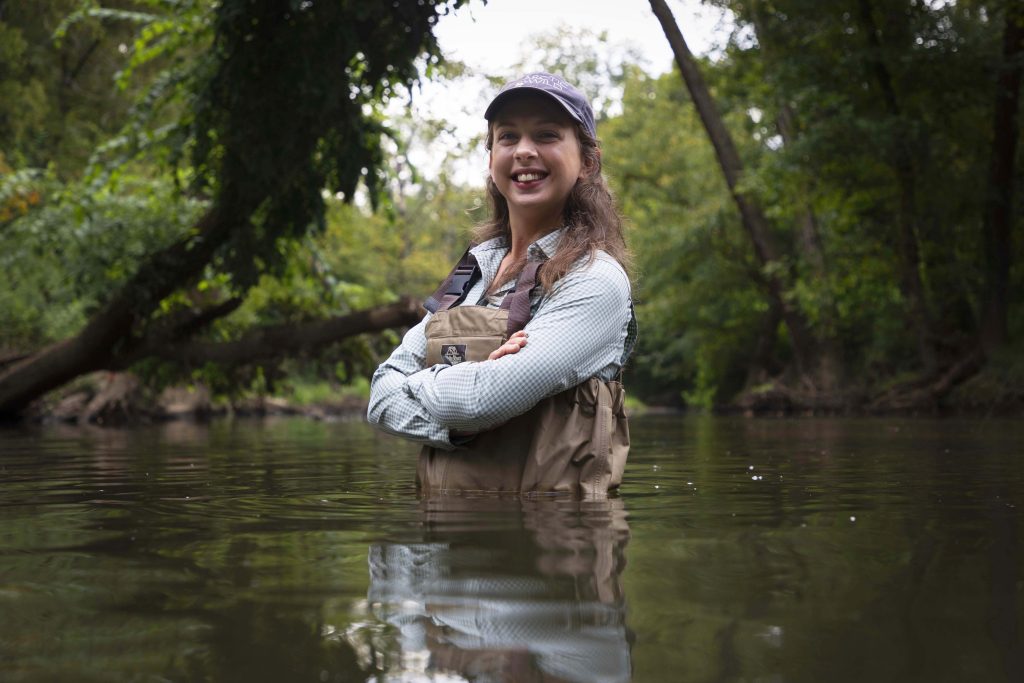Geological sciences doctoral student Julianne Davis studies the movement of mud and sand through subarctic rivers and lakes

Many days, you can find fourth-year doctoral student Julianne Davis outdoors. Specifically, you might find her around — or in — rivers and lakes.
As a researcher in the earth, marine and environmental science department, Davis studies the movement of mud and sand through these bodies of water in northern Canada and Alaska.
She says her childhood adventures served as the foundation for her deep appreciation of and fascination with the natural world.
“I was fortunate to grow up in a family that prioritized time outdoors, from our backyard to local hikes to cross-country trips,” said Davis.
Among those memories, a three-month, 20-state road trip across the country stands out as the experience that solidified her desire to explore the outdoors.
“I have many cherished memories from that trip but the ones that really stick with me are playing in the waves on Padre Island, a barrier island off the coast of Texas, and hiking in the snow in Sequoia National Park after waking up that morning to sunshine and 70o F weather at lower elevations,” she said.
Before arriving at Carolina, Davis followed that sense of adventure to a B.A. in geological sciences at State University of New York at Geneseo and an M.S. in earth sciences at Syracuse University. A “series of happy accidents” also led her to do two years of research on Martian craters and landforms before joining professor Tamlin Pavelsky’s Global Hydrology Lab at UNC.
In her fluvial research, Davis uses computer simulations and satellite images to explore where sediments are kept and released out of subarctic water systems.
“Sediment movement affects things like riverbank stability or collapse and lake shallowing which impacts navigability,” she said. “In northern places like the subarctic, where the climate is changing quickly, the processes are occurring in new and concerning ways.”
Her work has taken her to field sites in Alberta, Canada, and interior Alaska, including the glacier-fed Tanana River.
“From the plane, I caught glimpses of the chocolate milk-colored water full of fine sediments and the curved channels interweaving and diverging,” remembered Davis. “At one point, I turned to my advisor, Dr. Pavelsky, and said, ‘this is the kind of place that could make me believe in magic.’”
Davis finds that magic back home in Chapel Hill, too. In her department, she said it’s the people who have made her Ph.D. experience so positive.
“The warmth, excitement and passion of the people here is unmatched,” she shared, adding that Pavelsky has been an “incredible” advisor and that her friends, colleagues and cohort members have been a steadfast support system.
“While everyone cares about their work, there is also a strong emphasis on life outside of work and research,” she continued. For Davis, that includes kayaking and hiking.
As she looks to defend her dissertation next year, Davis shares that she is inspired to pursue work that helps others understand and connect with their local environments.
“I’ve learned so much through projects with community members and collaborating with experts in citizen science and public engagement,” she said. “The opportunity to learn directly from the people living in and interacting with these natural systems — hearing their stories, concerns, and understanding of the changes they see — has been an education that I never dreamed I’d have, but I know will influence my future work and career directions.”
By Jess Abel, College of Arts and Sciences
